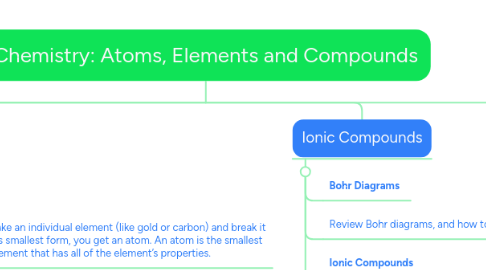
1. Matter
1.1. Matter
1.2. Matter is anything that has mass and volume. Mass is the quantity of matter in an object and volume is how much space it takes up.
1.3. For example, a brick has a certain mass and takes up certain amount of space. Mass is often measured in kilograms (kg) and grams (g). Volume is often measured in litres (L), millitlitres (mL).
1.4. Matter can be classified as a pure substance or a mixture. A pure substance I made up of one kind of matter, whereas a mixture is a combination of different types of matter or pure substances.
1.4.1. Questions
1.4.2. Explain how matter changes between the 3 different states.
1.4.3. What does adding heat do to particles of a solid? If we keep adding heat what will eventually happen to the distance between particles?
1.4.4. What is the difference between a heterogeneous and homogenous mixture? Give examples.
1.4.5. What is combustibility?
2. The Atom
2.1. Atomic Theory
2.1.1. When you take an individual element (like gold or carbon) and break it down into its smallest form, you get an atom. An atom is the smallest part of an element that has all of the element’s properties.
2.1.2. Atoms of different elements have different properties. For example, atoms of copper are not the same as atoms of iron.
2.1.3. Throughout many years scientists have developed an atomic theory to study the structure of atoms and how they combine to form matter.
2.1.4. Review the Periodic Table.
2.2. Questions
2.2.1. What are the charges and locations of the three sub-atomic particles?
2.2.2. What is an alloy? Give an example.
3. Molecular Compounds
3.1. Molecular compounds
3.2. Molecular compounds are substances created by combining non-metals only. In a molecular compound, atoms share electrons to complete electron shells. For example, a water molecule contains two hydrogen atoms sharing their electrons with one oxygen molecule.
3.3. The process for naming molecular compounds is as follows: The first element stays the same Prefix to first name is added to indicate the amount of first element atoms The second element has its ending change to “ide”. For example, chlorine becomes chloride, sulphur becomes sulphide. Prefix to second name is added to indicate the amount of second element atoms For example, N2O3 would be dinitrogen trioxide, and N3O2 would be trinitrogen dioxide.
3.3.1. Hazards and Benefits of Compounds
3.3.2. Chemicals are all around us. Some are very useful, while some can be very hazardous. We should all be aware of the chemicals around us, how they impact our environment, and how they impact our daily lives. Only after we are informed, can we make responsible decisions about our lifestyles.
3.3.2.1. Questions
3.3.2.2. Write the names of the following compounds: CO2 N2O SiF4 PBr3 CO
4. Ionic Compounds
4.1. Bohr Diagrams
4.2. Review Bohr diagrams, and how to specifically create them.
4.3. Ionic Compounds
4.3.1. Ionic compounds are substances made up of at least one metal and one non-metal. In an ionic compound the metal will form a positive ion and the non-metal will form a negative ion. The positive and negative charges attract each other. For example, table salt is sodium chloride made up of sodium ions and chlorine ions.
4.3.2. The process for naming ionic compounds is as follows: The first element (metal) stays the same The second element (non-metal) has its ending change to “ide”. For example, chlorine becomes chloride, sulphur becomes sulphide.
4.3.2.1. Questions
4.3.2.2. Give the name and symbols of 3 elements with complete outermost shells.
4.3.2.3. Draw the Bohr diagrams for lithium, nitrogen, magnesium, and sulphur.
4.3.2.4. Write formulas for the following ionic compounds. beryllium phosphide aluminum bromide lithium fluoride calcium iodide magnesium nitride gallium arsenide potassium nitride potassium selenide sodium chloride magnesium oxide
